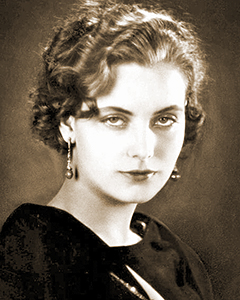
People active in the silent era and people who keep the silent era alive.
Copyright © 1999-2025 by Carl Bennett and the Silent Era Company.
All Rights Reserved.
|
|
 |
|
Photograph: Silent Era image collection. |
Greta Garbo

Born 18 September 1905 in Stockholm, Sweden, as Greta Lovisa Gustafson.
Died 15 April 1990 in New York, New York, USA, of pneumonia.
Sister of actor Sven Garbo and actress Alva Garbo.
Greta Garbo began working in motion pictures as a model circa 1921, appearing in advertising films. Her acting career began in earnest in Luffar-Petter (1922). Her appearance in Gösta Berlings saga (1924) began her artistic dependence on director Mauritz Stiller and led to her international recognition. Her last European film was Die Freudlose Gasse (1925) for German director G.W. Pabst, appearing with Asta Nielsen and Werner Krauss. In the summer of 1925, Garbo accepted an invitation from Metro-Goldwyn-Mayer to come to Hollywood to appear in American films.
Her first MGM film was The Torrent (1926) with Ricardo Cortez. As MGM explored what kind of roles were to be assigned to her, Garbo starred in The Temtpress (1926) with Antonio Moreno, Flesh and the Devil (1927) with John Gilbert (which ignited their love affair), and Love (1927) with John Gilbert. Then, in rapid succession, Garbo starred in The Divine Woman (1928) with fellow Swede Lars Hanson and directed by Swedish director Victor Sjöström, The Mysterious Lady (1928) with Conrad Nagel, A Woman of Affairs (1928) with John Gilbert, Wild Orchids (1929) with Nils Asther, The Single Standard (1929) with Nils Asther, and The Kiss (1929) with Conrad Nagel.
With Greta Garbo being one of the studio’s hottest stars, her transition into sound films was delayed and carefully managed by MGM as Garbo worked on her English speaking skills. Her first talkie was Anna Christie (1930) after which she continued in 13 more MGM features from 1930 through 1941, including her best-remembered films Mata Hari (1931), Grand Hotel (1932), Queen Christina (1933), Anna Karenina (1935), Camille (1936) for which she earned an Academy Award nomination, and Ninotchka (1939) with director Ernst Lubitsch.
References: Website-IMDb.
|
Book : Garbo by Barry Paris
Book : Garbo: A Portrait by Alexander Walker
Book : Greta Garbo by David Robinson
Book : Greta Garbo by Raymond Durgnat
Book : Greta Garbo by Richard Corliss
Book : Garbo by John Bainbridge
Book : Greta Garbo by Karen Swenson
Book : Garbo by Robert Gottlieb
Book : Greta Garbo by Judit Csengery
Book : The Great Garbo by Robert Payne
Book : Ideal Beauty: The Life and Times of Greta Garbo by Lois W. Banner
Book : Greta Garbo: Divine Star by David Bret
Book : Greta Garbo edited by Klaus-Jurgen Sembach
Book : Conversations with Greta Garbo by Sven Broman
Book : Garbo on Garbo by Sven Broman
Book : Walking with Garbo: Conversations and Recollections by Raymond Daum
Book : Greta Garbo: The Mystery of Style edited by Stefania Ricci
Book : Greta Garbo: The Swedish Sphinx of Silent Films by In60 Learning
Book : Greta Garbo: A Cinematic Legacy by Mark A. Vieira
Book : The Complete Films of Greta Garbo by Ricci Conway
Book : The Films of Greta Garbo by Michael Conway
Book : Loving Garbo by Hugo Vickers
Book : Greta Garbo: The Woman I Loved the Most by Armando G. Munoz
Book : The Savvy Sphinx: How Garbo Conquered Hollywood by Robert Dance
Book : Looking for Garbo by Jon James Miller
Book : Greta Garbo: A Hollywood Portrait by Marie Cahill
Documentary : Garbo by Kevin Brownlow and Christopher Bird (2005)
|
|
[Film Daily, 8 July 1925, page 1] Foreigners Arrive / Greta Garbo, prominent player of Sweden, and Mauritz Stiller, director, of the same country, have arrived in New York to join Metro-Goldwyn-Mayer. They will remain at the Commodore for two weeks and then go to the Coast.
|
|




































